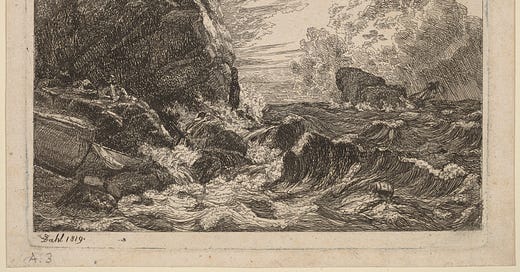[Image: Norwegian Coast during a Storm, 1819, Johann Christian Dahl, courtesy National Gallery of Art’s Open Access Collection, Epstein Family Fund. Public domain.]
The editors at Public Discourse were kind enough to let me continue the conversation about Fosse’s Septology in their pages. It’s a work one could discuss tirelessly for hours, which is one sure sign of its brilliance. This one is built for the ages: the kind of novel I remember, in my early years of serious writing, hearing people say Couldn’t Be Written Anymore.
Fortunately for us, brilliant writers don’t listen when everyone’s wringing their hands about What You Can’t Do Anymore. To quote from an utterly different but in its way equally perfect work: “They ain’t quit doin’ it as long as I’m doin’ it.”
In the Public Discourse piece I bring up some of Asle’s theological speculations, which may tend to be unsettling to the kind of a believer I am, one who cares about consistent formulation of teaching. But I posit that these speculations are meant not to descend to us from on high as novel (see what I did there) dogmas, nor are they put there for us primarily to judge and evalute, so much as they’re deployed to reawaken an all too often deadened contemporary appetite for metaphysical truth:
Fosse’s narration through Asle’s consciousness sets out to show us—as it sharpens our appetite for greater and higher knowledge than one story alone can provide, guides us toward the position that seeking such knowledge is itself a worthy part of the human endeavor, and dignifies one believing man’s work and prayer, joy and hope, grief and anxiety with the kind of loving attention that is the essence of natural contemplation.
This is true, I’d submit, even of the sorrowful and sometimes horrible things that happen to both Asles, especially to the young Asle. Near the end of The Other Name (I-II), Fosse’s art seems to want to show how one character manages not to remain stuck in past trauma, while it also demonstrates to other narrative artists one possible route to narrate a traumatic event clearly. It’s been a lively conversation, in literary circles: How do you tell a story of abuse or violence or destruction or all three, in short a story impinged upon by evil, without making that one evil moment the explanation for everything else the character chooses or becomes, and also without preemptively doing the judging for the character or the reader, but rather letting the event judge itself?
This raises many other questions but, I think, ones not disconnected from the book’s search after a clear vision of human and divine nature. Rather, they are directly linked to the novel’s implicit inquiry about theodicy: what kind of God allows such events to transpire? allows us to choose so recklessly, to ruin each other so casually? Jonathan Geltner has written at length and compellingly about the novel’s response to these questions, but there is much more to be said. Would that we could slow down long enough to say some more of it.




